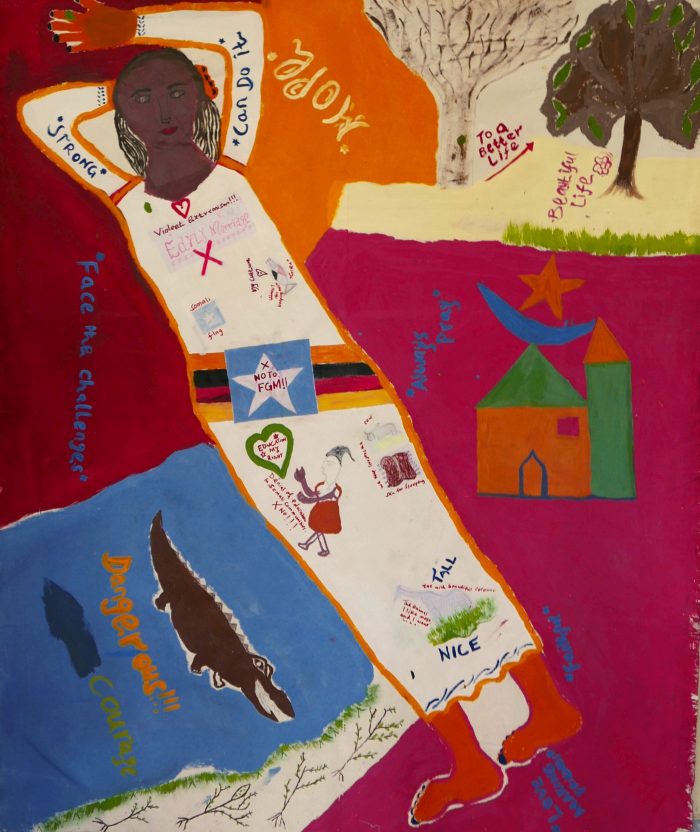Habiba
Stand Strong
I love this work. I am very proud. I had an amazing time and it helped me so much to reflect on myself.
You see, I am dressed in the Somali way. The beautiful white with 4 coloured stripes, that is me.
My Somaliness – I am proud of it. This is normally the dress of a woman during the wedding celebration. It shows the time when they wanted to marry me. I was very young but I did resist. On my left hand, I have this ring. One day, I will marry the man of my choice.
I painted my face with that brown colour showing a kind of ‘ugliness’ in terms of appearance because I was not ok. I was angry by that time.
My hands are crossed behind my head. They fight. They convey a message: “I am strong and I can do it”. I have opened my hair as well, without a scarf: I am a woman and my hair brings out my openness: I am opposing, resisting my culture – the girl’s lack of education, the early marriage, the FGM. I resist and I can go further, do more. With my legs I can still walk. I go beyond what they expect from me.
I have drawn the Somali flag and I have written: “No to FGM!”
I do resist FGM. I hate the practice in my community. Fortunately, the government is helping the girls and some communities have even stopped FGM in Kenya, but, for us Somalis, it is still there. It is an act of violent extremism. I wish I could have the power to stop these people.
It is happening inside me, I can feel deep inside. My people who are responsible. They are not facing up to that crime but I have to live with it. I was in Class Three when they did FGM to me. I thought I was dying, over-bleeding. I did not have any choice, no opportunity to refuse. They forced me, and you are still a child. The big mums will catch you and force you. This is why I wrote “NO TO FGM” in red colour because it is dangerous.
It took me three weeks to heal. We were several girls at that time. I faced more pain during the first week but slowly I recovered until I was allowed to come out from the manyatta (home). These are houses built by the pastoral community from mud, sticks, and makuti (palm leaves) as temporary settlements because they like to move around. I was just sitting playing with pebbles with my sister. After a moment I saw blood coming out of me. I was confused. I bled until I lost consciousness. When my mum came that evening, they could not send me to the hospital because FGM in Kenya is illegal. It took six long days for me to recover. Even after healing, you feel the sound of the razor blade cutting you. Just remembering it is like they are doing this to me again now. I was in a state of dying, but Allah saved me. In Tana River, they use razor blades, but in some parts of Garissa – I saw it – they are using knives. They even take a spoon into the fire, then they burn it.
What hurts me is that the FGM practitioners are women. They even celebrate the one who is strong, who never cries in that state, and afterwards they do that sound, ululating. I can still hear it. If I have a daughter one day, I will not allow them to touch her.
I drew two trees: one is dry and has no leaves. The other has leaves and fruits. It resembles my life, from all the difficulties that I have been through to a better and beautiful life. There is the mosque, the moon and the star, and what we call the mimbar (pulpit), where the leader or the sheikh usually stands and leads the prayers. I am always that person who, in times of difficulties or in times of happiness, has to pray. It is safe for me. When things go wrong, I always go back to read the Quran and that is how I feel very comfortable.
I love green; it shows that education is life. I did not draw a boy but I drew myself as a girl because it is generally girls who are denied education.
I choose yellow for hope because it is bright and unique. That hope brings me that strength of facing the challenges, because I believe in changes.
When I was asked on the first day of the workshop which animal I resembled, the giraffe came to my mind. It is tall like me. It stands in the grass, this fertile ground, standing for a better life.
The place where I am from in Tana River is full of crocodiles. It is a danger for everybody, not only the Somalis but also the Ormas and especially the Pokomos because they live near the river. Unfortunately, in my region, there is a lot of tribalism and harassment at times. Different communities are fighting along the Tana River for the land, the water, the grazing. It is something that makes me feel sad at times.
My artwork is called “Stand Strong”, I drew my body map to represent me, my life, my background and what I really wish to be, able to walk in different places where I can do a lot, have that courage that, as a girl or as a woman, I can do what is good. I was so happy to interact with different people, different cultures and share ideas. I felt so special.

